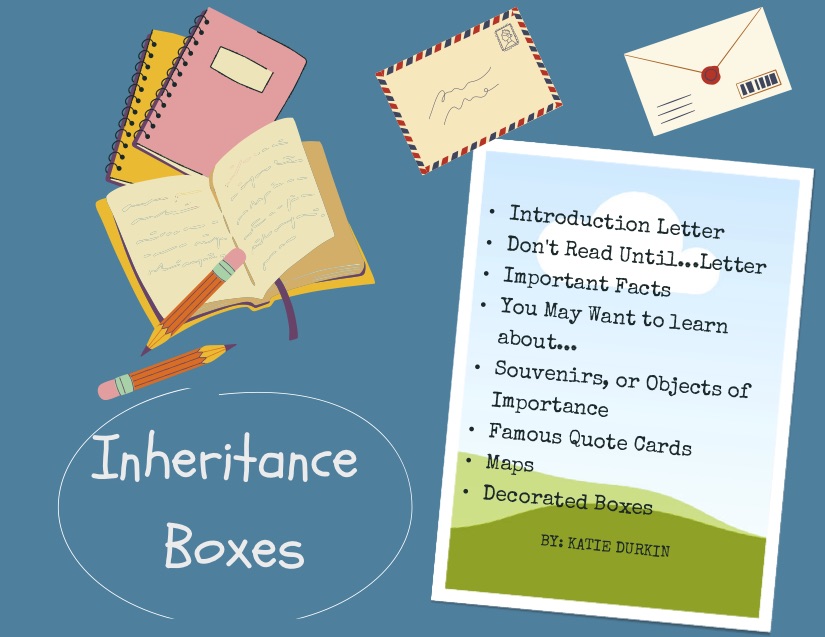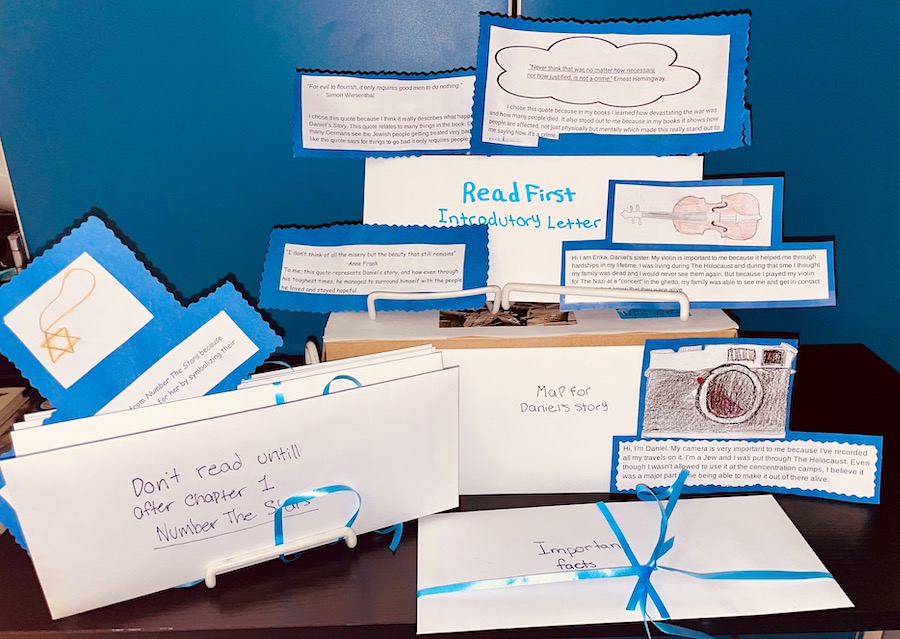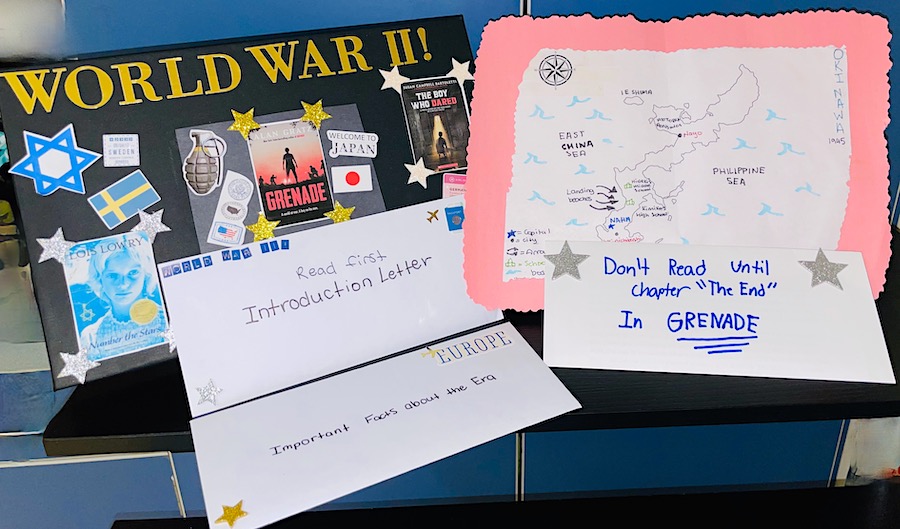Inheritance Boxes Help Kids Share Knowledge
Seventh graders pass along what they’ve learned to future classes in this Inheritance Box project, part of a literacy + history unit.
The end of any unit presents us with opportunities to assess and celebrate student learning in myriad ways. One of my favorite projects each year comes at the end of our Historical Fiction unit, where students create what we have come to call Inheritance Boxes.
These boxes are a way for my 7th graders to introduce next year’s students to historical fiction and help them choose which historical era they’d like to study during our 8-week unit.
The boxes are filled with artifacts, letters, and objects that help me assess the skills we have worked on developing during our examination of historical writing (nonfiction comes into play too). The boxes also provide an opportunity for communication between students across grades.
In this article I’ll introduce you to how my teaching team assigns and facilitates the creation of the inheritance boxes, share some of the artifacts students create for this project, and suggest ways you can adjust or change this assignment to fit the needs of your curriculum or content area.
What the unit looks like
The idea for inheritance boxes was adapted from the final lesson in the Teachers College Reading Workshop unit focused on historical fiction, where small groups of about three to four students study the same historical era (Ehrenworth & Wolfe, 2017).
During our unit students read one historical fiction story, using only their previous knowledge of the era to help them comprehend the text. They then spend time reading and viewing nonfiction pieces about their chosen historical era – specifically primary source images and documents, articles, maps, and videos – to help them begin to build their background knowledge of the time period.
Students then read a second book from that same historical era, using what they learned from the first book and their nonfiction research to assist with their comprehension. At the end of the unit, students work with their groups to create inheritance boxes and leave a legacy for next year’s students who “inherit” their knowledge.
What goes in the boxes
Here are the items students create for their inheritance boxes:
► Introduction Letter: Students write a letter to next year’s students introducing them to the unit, the historical fiction books they read as a group, and the contents of the inheritance box. In this letter I ask students to introduce themselves, give a little bit of background about the era they studied, give a brief synopsis of the books, and provide future 7th graders with some tips for how to approach the reading and assignments for the unit.
I ask students to follow a friendly letter format, including an address, date, salutation, and closing. This gives students an opportunity to practice their letter-writing skills, as well as think about what next year’s students need to know before they choose their books and the historical era they want to study.
This letter is written by the entire group and sealed in an envelope that instructs next year’s students to read this letter first.
► Don’t Read Until…Letter: Students individually write a second friendly letter to next year’s students that they don’t open until they have read up to a certain point in one of the books. Students are asked to choose a particular part of the book that they believe was thought-provoking, exciting, or important.
Once they have chosen the part of the book they want to highlight, each student writes a letter in the form of a written conversation. Similar to the Introduction Letters, students start the letter by sharing a little bit about themselves and then delve into talking about the story.
I ask students to think about this like having a conversation with someone, just writing it in a letter. They are free to share connections, questions, reactions, and more to get next year’s students thinking about a particular part of the book. These letters are sealed and labeled with “Don’t Read Until…”, identifying the chapter name or number, and title of the book, so next year I know when to give students these letters to read.
► Important Facts about the Era: To practice the skills learned during the unit related to nonfiction, students collaborate to create a list of ten important facts they believe students should know before they start the unit. Students are asked to choose facts they believe will benefit next year’s students in comprehending their group’s historical fiction books.
► You May Want to Learn About: To evaluate their vocabulary skills in relation to nonfiction, students create a list of historical terms they believe students need to know to help them better understand their era and historical fiction books generally.
For this assignment, students don’t define the terms for students; rather they share why they believe students need to know these terms in order to understand the history and fiction associated with the unit. This work requires students to critically think about what they learned and how it would benefit students next year when they start the unit.
► Souvenirs or Objects of Importance: To help students think about symbolism in a historical fiction book, they are asked to choose a specific object from one story that represents something important to the character. This object could be of historical significance, relate to a character’s journey, or showcase something the character learned in the book. Students are asked to create or draw this object, accompanied with a short description attached, explaining why it is important to one of the historical fiction stories.
► Maps: To collaborate with our Social Studies counterparts, who focus on geography in 7th grade, students create a map to show next year’s students where some of the historical fiction stories take place. As the settings for the historical fiction books span the globe, next year’s students are able to see the specific locations of the stories. Students use the maps to be creative, tracking the journeys some characters made in the stories or labeling the places where they live.
► Famous Quote Cards: Students choose a quote – either from the book itself, or from a writer, poet, or historian – that they believe represents a major theme from the historical era they studied and one of the books they read. This assignment relates to one of the foci for the unit which requires students to think about why we read and study both history and historical fiction. Students explain how the quote relates to a theme from the story and era, focusing specifically on enticing students to choose the books and era to study.
► Decorated Box: Students really enjoy decorating their boxes to showcase their books and historical era. The only requirement is students need to ensure the outside of the box is clearly labeled with their historical era as well as the names of the group members.
Students have fun drawing and creating objects to display on their box, making them inviting to next year’s students in the hope that they will examine the artifacts and letters inside.
A flexible teaching/learning strategy
Inheritance boxes can be adapted for any subject, genre, or unit. While the items my students create for these boxes are specific to historical fiction, other teachers can think about “boxing” student work as a way to introduce new students to a unit or topic.
This project usually takes about a week to complete if students solely work on the assignments in school. I start preparing for this project a week in advance, asking students to bring in empty shoeboxes from home. This gives me time to ensure I have enough boxes for all of my groups.
While the finished boxes do take up a lot of storage space in the classroom, I always return them to the previous groups the next year after my latest crop of students have viewed the boxes through a gallery walk. By doing this, I am not keeping the same boxes more than a year. The turnover system also allows me to refresh the tasks so they meet the needs of a new crop of students.
Summing up
The inheritance boxes offer my students an opportunity to discuss, create, and collaborate, showcasing artifacts whose audience is not primarily the teacher.
While the boxes do provide me with an opportunity to assess students’ skill development, the projects have other benefits: we can also have discussions about how to approach working in a group to collaboratively complete a project, as well as how to ensure our work is polished enough for others to read.
Year after year students are inheriting knowledge from their peers through this project strategy, providing an opportunity for student voices and student-generated work to inform the decisions of future learners about how they would like to approach a unit of study.
References
Ehrenworth, M., & Wolfe, P. (2017). Historical fiction book clubs. Heinemann.
Katie Durkin (@kmerz610) has been teaching English Language Arts to middle school students for a decade and currently teaches 7th grade Reading Workshop at public Middlebrook School in Wilton, Connecticut.
Katie is a zealous reader of middle grades and young adult books and enjoys sharing her love and passion for reading with her students. She is completing her doctorate at Northeastern University studying the impact of classroom libraries on middle school students’ reading engagement. She’s also the 2020 recipient of the Edwyna Wheadon Postgraduate Training Scholarship from the National Council of Teachers of English.


































